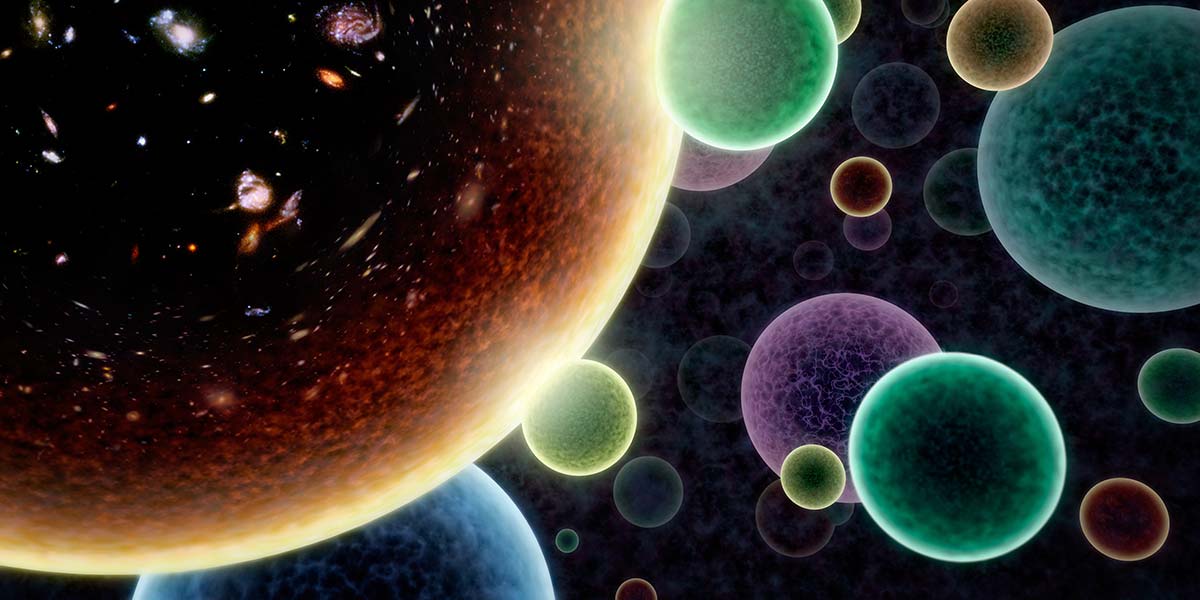Astronomers tell us that our universe is not only expanding, but that it’s accelerating its expansion. The precise explanation for the accelerated expansion is a mystery. One general view is that the universe is permeated with a material of negative pressure creating a gravitational repulsion. This material has become known as dark energy.
Cosmologists conjecture that the negative pressure may be caused by the vacuum of space itself — which might be the case if the vacuum had a positive energy density. Concepts such as energy density and negative pressure are difficult for most of us to understand since we don’t see them in our daily lives.
In this article, we’ll explore these ideas and analyze an electrical model with similar properties that is constructed with some copper plates and an electrometer. Comparing this model to the cosmological model of our universe should help us understand these concepts and emerging theories of the cosmos. Hopefully, in the process, we’ll learn more about how our fantastic universe works.
The universe is a big place and getting bigger all the time. Figure 1 is a Hubble Space Telescope (HST) ultra-deep field photograph of a very tiny patch of sky — thought to be totally dark, devoid of stars and galaxies.
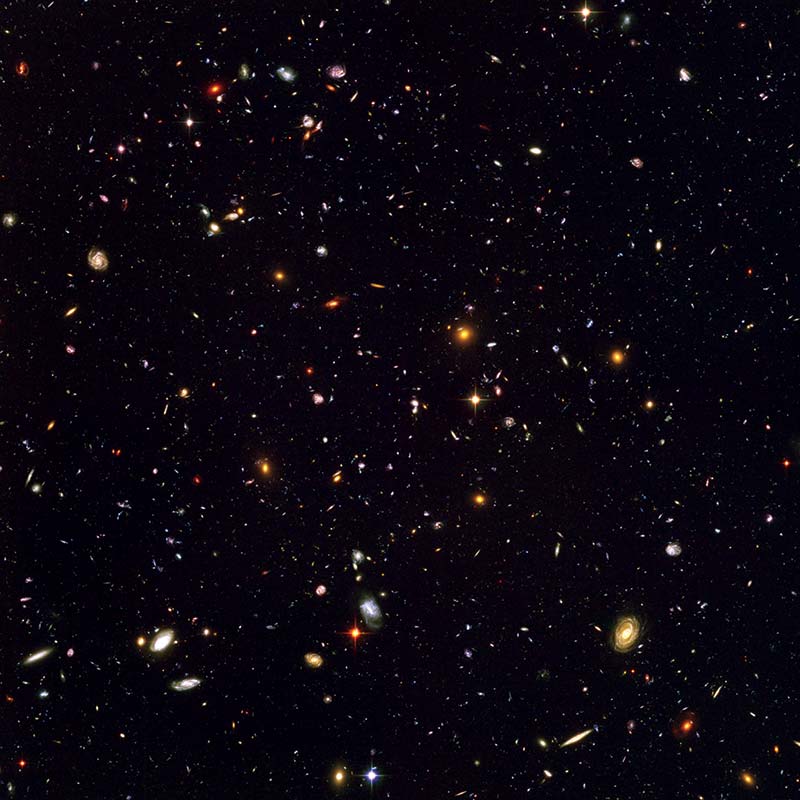
FIGURE 1. Galaxies are everywhere as far as the Hubble Space Telescope can see. This view of nearly 10,000 galaxies is the deepest visible-light image of the cosmos. (Image courtesy of NASA, ESA, S. Beckwith, and the HUDF Team.)
By adding up the light over 10 days, however, the HST was able to build up a spectacular picture. The result shows thousands of distant galaxies with a myriad of shapes and sizes, providing a direct view of the adolescent universe when it was still forming billions of years ago. It is a good impression of what the cosmic sphere looks like all the way out to the most distant visible galaxies.
Pictures such as this — while captivating — are a bit deceiving since they make it seem that galaxies are close to each other. In actuality, they are hundreds of thousands to millions of light-years apart. The space between galaxies is filled with a tenuous gas having an average density of less than one atom per cubic meter. This is in contrast to the space between stars in a galaxy — known as the interstellar medium — which is filled with gas, dust, cosmic rays, and electromagnetic radiation.
Cosmologists believe this nearly perfect vacuum of space may also contain a dominant mysterious material. They think that this substance has constant energy density and fills space with negative pressure. To help us understand these unusual concepts, we’ll study a model of a system with similar properties using an electrometer and copper plates as mentioned earlier. However, before we get to that, let’s review how we came to understand our accelerating universe.
Einstein’s Static Universe
The cosmic sphere is a very useful way of compiling astronomical observations of the region of the universe around us, but it ignores the fact that the universe is expanding. Expansion controls the temperature, density, and composition of the universe, and the formation of astronomical structures. Einstein’s theory of gravity was the first to realize that space and time form an elastic material called space-time that can be stretched and contracted due to the gravitational force that a massive object has on the space around it.
Imagine for a moment that all of space is filled with a nearly uniform distribution of matter, radiation, or other types of energy. According to Einstein’s theory, the entire universe can expand or contract, just like the overall stretching or shrinking of an elastic substance. While Einstein believed in his theory, he didn’t like the idea of an expanding or contracting universe but preferred a model in which the universe is static and eternal.
As a consequence, Einstein introduced an extra form of energy specifically designed to oppose the gravitational attraction of matter. He didn’t know what form this energy would take, so he simply introduced it into his equations as a cosmological constant which predicts a repulsive gravitational effect, causing space to expand rather than contract.
In this model, Einstein finely adjusted the repulsive gravity of the cosmological constant to precisely counter the attractive gravity of matter. By setting the opposing influences in perfect balance, he was able to construct a static model of the universe. However, this situation is contrived and unstable. Unless the balance between forces is perfect, the universe either collapses rapidly or blows up!
Hubble’s Expanding Universe
Some years after Einstein’s proposal, came experimental evidence that the universe is not static. In the 1920s while working at the Mt. Wilson Observatory with the most advanced technology of the time, Edwin Hubble showed that some of the numerous distant faint clouds of light being observed were actually entire galaxies — much like our own Milky Way. The realization that the Milky Way is only one of many galaxies forever changed the way astronomers viewed our place in the universe.
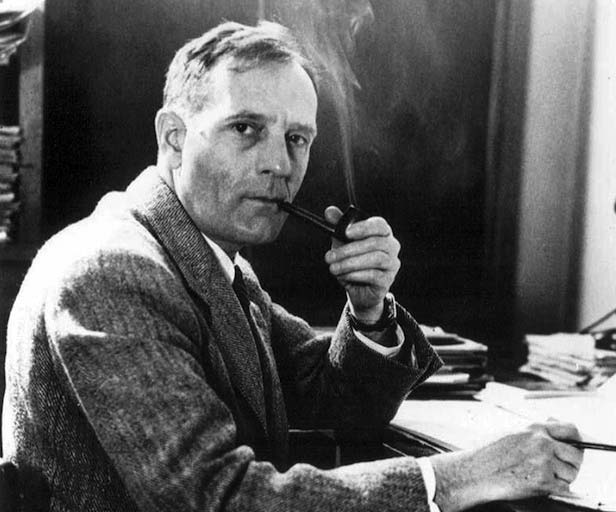
FIGURE 2. Edwin Powell Hubble was an American astronomer. He played a crucial role in establishing the fields of extragalactic astronomy and observational cosmology, and is regarded as one of the most important astronomers of all time. (Image courtesy of NASA.)
Hubble’s greatest discovery came in 1929, when he determined that the farther a galaxy is from Earth, the faster it appears to move away. This notion of an expanding universe formed the basis of the Big Bang theory, which states that the universe began with an intense burst of energy at a single moment in time — and has been expanding ever since.
If the universe were static as Einstein wanted, Hubble might have found the motion of galaxies to be random with motions in all directions. Instead, he found something extraordinary: All the galaxies are moving away from us.
When Hubble plotted the velocity of the galaxies against their distance, he came across an interesting relationship shown in Figure 3.
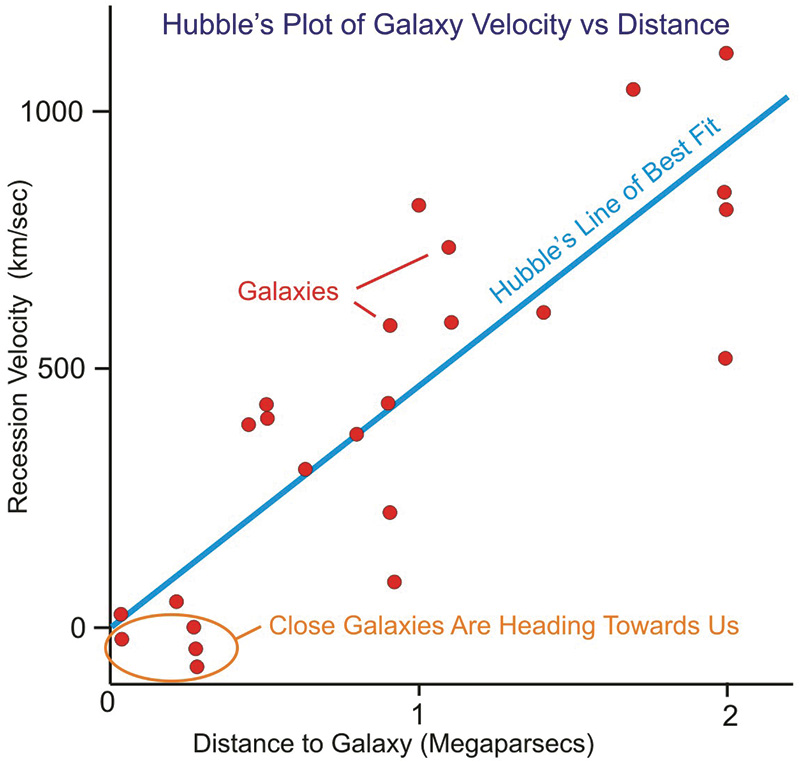
FIGURE 3. Plot of Hubble’s distance-velocity relationship for galaxies based on his original data.
This is now known as Hubble's Law and is interpreted as evidence for an expanding universe. The slope of the line, Ho, is the Hubble constant. It represents the constant rate of cosmic expansion caused by the stretching of space-time itself.
Cosmologists say the galaxies are not moving through space, but rather they are moving in space because space is also moving. A picture to explain the expanding universe is to imagine the universe like a loaf of raisin bread dough, with galaxies being the raisins. When heated, the bread dough expands, the raisins move farther away from each other, but they are still fixed in the dough. Similarly, all galaxies in the universe move away from one another because of the expansion of space in the universe.
The Universe is Accelerating Its Expansion
In the early ’90s, cosmologists were fairly certain about the expansion of the universe. They thought it might have enough energy density to stop its expansion and collapse or it might have so little that it would continue expanding. In either case, gravity was certain to slow the expansion as time went on. Granted, the slowing had not been observed, but theoretically it had to slow. After all, the universe is full of matter and the attractive force of gravity pulls all matter together.
Then in 1998, Saul Perlmutter and his group announced to an astonished crowd at the American Astronomical Society that they had found evidence that the separation velocity between galaxies has not been slowing down as expected but, in fact, was speeding up. The group used type 1A supernovae as standard candles to measure distance and the redshift of their spectra to measure their expansion rate. Since looking far out into space is equivalent to looking back in time, this procedure allowed the astronomers to probe the expansion rate at a much earlier time than Hubble or any other measurement.
So far, there is no precise explanation for the accelerated expansion. It seems that the universe is filled with a material of negative pressure, creating a gravitational repulsion. The negative pressure material has become known as dark energy. Assuming the standard model of cosmology is correct, the best current measurements indicate that dark energy contributes 68% of the total energy in the present-day observable universe.
One possibility for dark energy is the negative pressure caused by the vacuum itself, which would be the case if it had a positive energy density. A vacuum energy density would be exactly equivalent to what Einstein called a cosmological constant.
Our intuition rebels at the thought of attributing energy density to a vacuum. However, we should bear in mind that particle theorists see the vacuum as a complicated state in which “virtual” particles are constantly appearing and disappearing in quantum fluctuations. These "virtual pairs" consist of one particle with a negative charge and one with a positive charge. They exist for only a tiny fraction of a second before they collide and annihilate each other in a tiny burst of energy. This energy may be pushing outward on space itself, causing the universe to accelerate faster.
However, much to the consternation of cosmologists, particle physicists seem to be having a problem understanding how the energy density of the vacuum could be so amazingly small because it contradicts the predictions of quantum field theories. These theories predict vacuum energies that are so large that the universe shouldn't exist at all. This discrepancy is called the "old" cosmological constant problem.
It’s safe to say that particle physicists are working hard to solve this problem. We’ll have more to say about this subject in a later section. In any case, it’s now time for a demonstration that an expanding space can have a constant energy density and negative pressure.
Demonstration of Constant Energy Density in an Expanding Space
A large parallel plate capacitor contains within its properties similar qualities to those found in the dark energy of the universe. For this experiment, two large six inch square/single-sided copper boards were utilized to act as a parallel plate capacitor and a Keithley model 616 electrometer for making measurements. The copper boards were mounted on wooden blocks so that they could easily slide on a surface and be put close together. A photo of these items is shown in Figure 4.
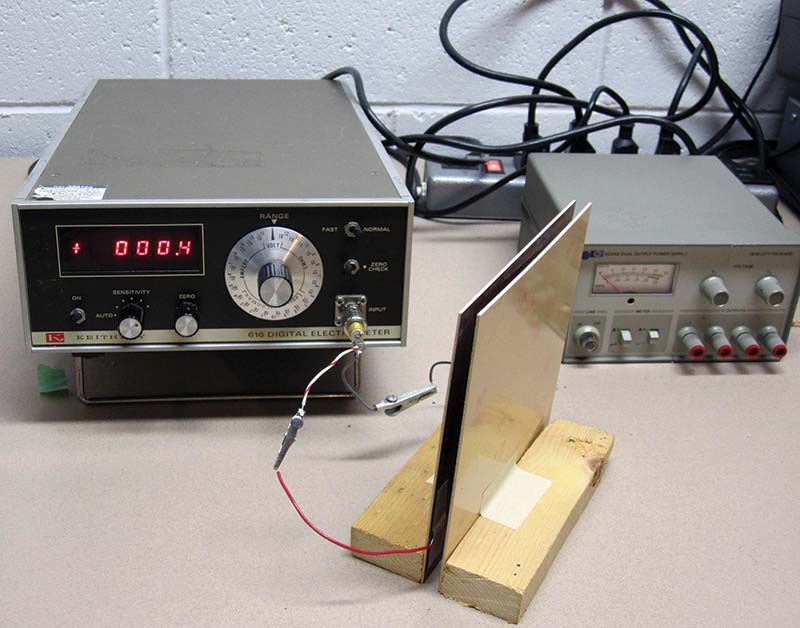
FIGURE 4. Photo of the electrometer and parallel plate capacitor used in the experiment.
An electrometer is a device for indicating charge or voltage and is often found in high school and college labs. It has certain characteristics which enable reliable measurement from very high source resistance. When used to measure voltage, the input resistance is greater than 10,000 giga-ohms. As a result, the loading of the source circuit is relatively insignificant when compared to a digital voltmeter having 10 mega-ohms input resistance.
The goal of this demonstration is to show that the energy inside the capacitor plates has a density that remains constant as the plates are pulled apart and whose negative pressure has the same magnitude as the energy density.
Refer to Figure 5 for the equipment setup. The procedure is as follows: First, the plates are brought close together without touching, with one of the plates grounded. Next, the other plate is electrified by briefly touching it to a voltage source; typically 10 volts. This process transfers an amount of charge Q to the plates.
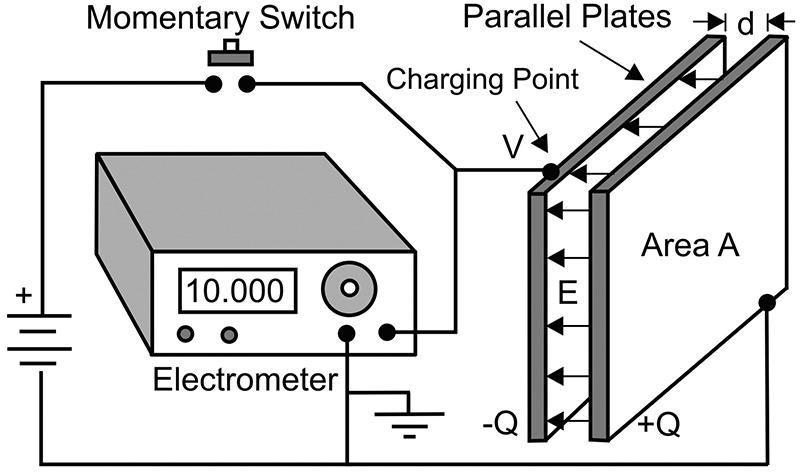
FIGURE 5. Schematic of the experimental setup for the parallel plate capacitor with Area A and separation distance d. An electrometer is used to measure the voltage across the plates.
Next, the plates are pulled apart slightly, being careful not to touch them together. The electrometer now shows an increase in the voltage across the capacitor — the amount depending on how far the plates are separated. The increase in voltage tells us that there is an increase in the energy stored in the capacitor. In practice, the voltage across the capacitor will jump, then slowly drop due to the loading of the electrometer. The jump in voltage as the plates are separated is easily seen.
Energy in the Capacitor
Now, let’s calculate the energy stored inside this parallel plate capacitor. Recall that whenever a parallel plate capacitor is charged, the two plates receive equal and opposite charges ± Q. We begin by assuming a uniform electric field E between the plates, ignoring any fringing effects as shown in Figure 5.
You can either use Gauss’ law to find Q or use the relation Q = C V for a parallel plate capacitor, where C is the capacitance and V is the voltage. A parallel plate capacitor has the value C = ε0 A/d where ε0 is the permittivity, A is the area of the plate, and d is the distance between the plates. The electric field for this case is E=V/d, so after some simple algebra, we have the following result:
(1) Q = ε0EA.
This shows that Q is proportional to E, since ε0 and A are fixed constants. To calculate the energy stored in the capacitor, let’s assume that the plates are separated by pulling on the positive plate from near zero to d. The work W done is the force F times the separation d and must be equal to the energy stored in the capacitor ½ QV = ½ QEd. Combining this with (1) results in:
(2) W = F d = ½ QEd = ½ ε0E2Ad.
Since E remains constant as the plates are pulled, it should be clear that the energy in the capacitor is proportional to the volume (Ad). To get the energy density ρ, divide by the volume (Ad):
(3) ρ = ½ ε0E2 (energy density between plates).
Since E and ε0 do not change as the plates are pulled apart, we see that the energy density in the capacitor does not change when the volume between the plates is expanded.
Where is the Negative Pressure?
Notice that when the plates are being pulled apart, the electric field E is pulling them together. If a balloon is placed between the plates and filled with air, it would tend to push the plates apart — a positive pressure. Since the electric field is pulling in the opposite direction, it’s exerting a negative pressure. It’s easy to show that the negative pressure p has the same magnitude as ρ and equals:
(4) p = - ½ ε0E2 (which is the pressure on the plates)
The Role of Vacuum Energy in Space
The energy density between the capacitor plates behaves in some ways like the vacuum energy of space. It is thought that the vacuum energy density of space ρ is constant throughout all of space and produces a negative pressure p = - ρ, unchanging even if the space is enlarging. In our simple experiment, when we enlarge the space between the plates, the extra energy comes from doing work by pulling the plates apart. Cosmologists tell us that in an expanding universe, the extra energy comes from gravitational potential energy.
It’s not obvious why the negative pressure causes the universe to expand. Intuitively, we might think that it should cause the universe to pull or contract. What really matters is the gravitational effect of the negative pressure. In Einstein’s general relativity (unlike Newtonian gravity), both the pressure and the energy contribute to the force of gravity.
When Einstein's law of gravity is reduced to its basics, the sign of the gravitational force is determined by the algebraic combination of the energy density plus three times the pressure (three because there are three dimensions of space). So, we have:
(5) g (gravity) = ρ (energy density) + 3p (pressure)
If the pressure is positive — as it is for radiation, photons, neutrinos, and matter from the early universe — the combination is positive, and gravitation is attractive. If the pressure is negative, it can cancel out the energy density, reducing gravity in the process.
If the pressure is negative and big enough, then the sign of the gravity force in Einstein's equation actually reverses. This happens if (ρ + 3p) is negative. Instead of gravity attracting, it repels.
Astronomical data says that dark energy is positive, so negative pressure is what is needed for accelerated expansion. Among the dark energy contenders, vacuum energy in the space between galaxies may meet this condition, provided its density is positive.
Cosmologists say that negative pressure associated with dark energy is so large that it overcomes the positive (attractive) effect of the energy itself, so the net effect is a push rather than a pull. This results in a net repulsive gravitational field in intergalactic space.
The appeal of vacuum energy to cosmology is that it could explain why the acceleration has only started fairly recently on the cosmic timescale. In the early universe, all the matter was packed much more densely than today, so there was less space between galaxies. Everything was so close together that gravity was the dominant force, slowing down the acceleration of the universe that was imparted in the Big Bang. Also, since there was less space in the universe and the vacuum energy comes from space itself, it played a much smaller role in the early universe.
The universe has grown much larger in the 13.7 billion years after the Big Bang, so the galaxies are not packed so close together. Their gravitational pull on each other is weakened, allowing the vacuum energy to play a more dominant role.
Vacuum energy has its own problems. To match the astronomical data, we require a vacuum energy density of ρ ≈ 10-8 ergs/cm3. Unfortunately, physicists are unable to reliably calculate the expected vacuum energy in the real world or even in some specific field theory such as the Standard Model of particle physics. The best they can do is to offer order-of-magnitude estimates.
Using quantum-mechanical zero-point vacuum fluctuations has led to an estimate of ρ ≈ 10112 ergs/cm3 which is off by 120 orders of magnitude! Despite this huge disparity, most cosmologists still consider vacuum energy as the most complete scenario to-date. So, it leads the group of dark energy contenders.
Vacuum Energy and the Multiverse
Problems with finding the correct value for the vacuum energy have led to a controversial idea that our universe is just a random bubble in an endless, bubbling multiverse (see Figure 6) that arises logically from nature’s most innocuous feature: empty space. As the hypothesis goes, the seed of the multiverse is the inexplicably tiny amount of energy infused in empty space — energy known as vacuum energy, dark energy, or Einstein’s cosmological constant.
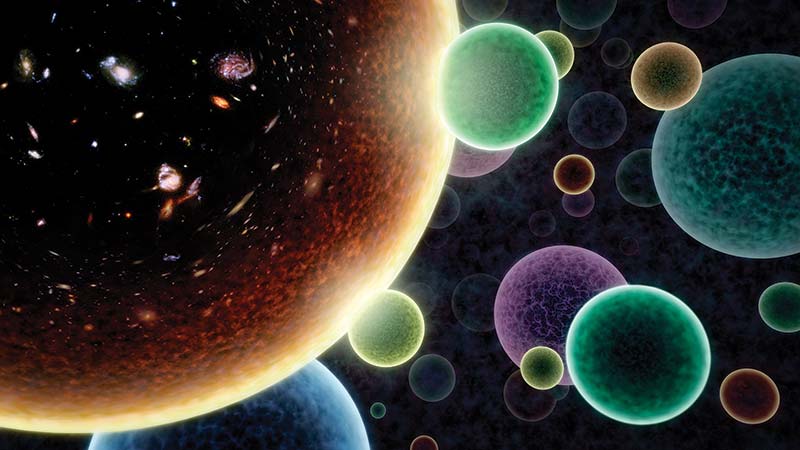
FIGURE 6. Illustrated here is the concept of an alternate "bubble" universe in which our universe (left) is not the only one. Some scientists think that bubble universes may pop into existence all the time, and occasionally nudge ours. Some bubbles would inflate wildly, while others would collapse back on themselves. Our own bubble universe just happens to have the right amount of matter and other variables to endure and foster the creation of stars and planets. (Image courtesy of NASA/JPL-Caltech/R. Hurt.)
Nobel laureate Steven Weinberg once said that the vacuum ought to be many trillions of times more energetic because of all the matter and force fields coursing through it. So, why is space so empty? While we don’t know the answer to this question, the extreme vacuity of our vacuum seems necessary for our existence.
If the vacuum energy had even slightly more of the gravitationally repulsive energy, space would expand too quickly for structures like galaxies, planets, or people to form. This fine-tuned situation suggests that there might be a huge number of universes all with different doses of vacuum energy, and that we happen to inhabit an extraordinarily low-energy universe because we couldn’t possibly find ourselves anywhere else.
This reasoning leads to the anthropic principle: A philosophical idea that observations of the universe must be compatible with the conscious and sapient life that observes it. It says the universe's ostensible fine-tuning is the result of selection bias: our observance of only this universe, compatible with our life. Only in a universe capable of eventually supporting life will there be living beings capable of observing and reflecting on the matter.
These arguments depend upon the concept of the multiverse for there to be a statistical population of universes to select from and from which selection bias could occur.
Many scientists bristle at the tautology of “anthropic reasoning” and dislike the multiverse for being untestable. Even those open to the multiverse idea would love to have alternative solutions to the cosmological constant problem to explore. So far, it has proved nearly impossible to solve without a multiverse.
In his last paper, the renowned physicist Stephen Hawking and Thomas Hertog offered an interesting departure from earlier ideas about the nature of the "multiverse." According to the new theory of eternal inflation, there was a boundary in the past, so time and space had a beginning. The universe that emerged from that state is also finite, making it far simpler to deal with — and test scientifically. If that turns out to be the case, it deals a blow to the concept of a multiverse containing endless pocket universes.
Another glimmer on the horizon is the emergence of a new theory of a cyclic universe proposed by Paul Steinhardt (Princeton) and collaborators; refer to Figure 7.
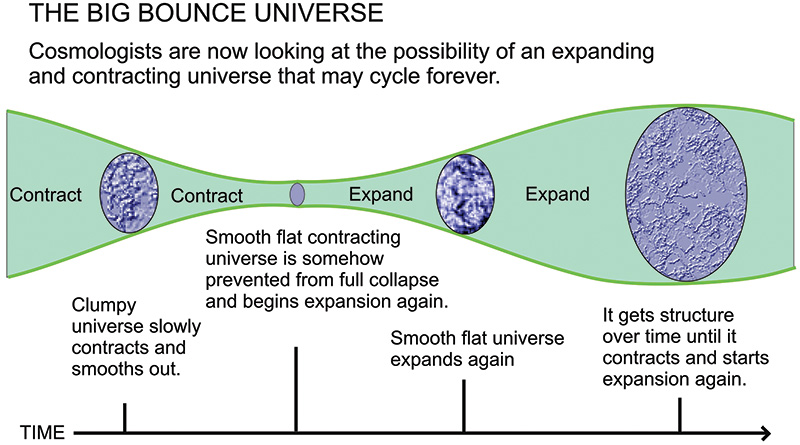
FIGURE 7. Illustrated here is the new theory of a cyclic universe. There is no big bang, and cosmic history consists of repeated cycles. It eliminates problems in current models but creates some of its own.
According to this theory, our cosmic history consists of repeating cycles of evolution. Each cycle begins with a bounce — not a bang — but the bounce is not the beginning of space or time. Rather, it’s an event with a “before” and an “after” that can be described by the laws of physics.
Steinhardt argues that contraction at the end of a cycle — rather that eternal expansion — can solve all the problems that the current Big Bang theory poses. It smooths out variations and gives rise to large scale uniformity and cosmic structure without any more assumptions.
The cause of the proposed contraction is not well understood, but neither is the inflation in the Big Bang model. Steinhardt adds that this bouncing scenario has the advantage of not predicting an infinite number of universes.
In this theory, each cycle affects the next. Events that occurred before the last bounce shaped the large-scale structure of the universe observed today, and the events that are occurring today will determine the structure of the universe in the cycle to come. Perhaps space and time sprang into being many cycles ago, but it is also possible that they are literally “endless.”
However, don’t raise your hopes too high, as this cyclic universe theory is still in its infancy and there are many problems to solve. Remarkably, however, this new theory of a cyclic universe is able to match all current astronomical observations with the same accuracy as the Big Bang picture, and it may explain some aspects of the universe that the Big Bang picture cannot. Only time will tell if this theory survives.
We are fortunate to exist in a rare period of time where competing theories of the universe are being thrashed out. This debate may strongly affect the way one views the universe and humanity’s place in it. NV

